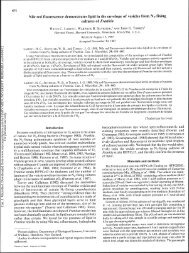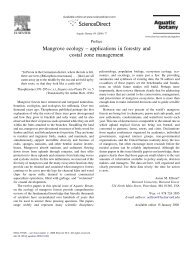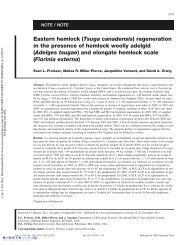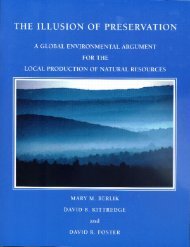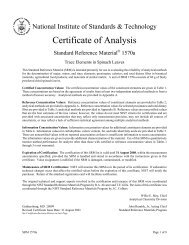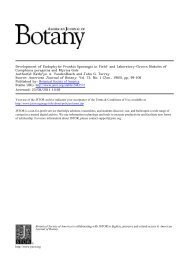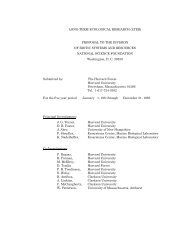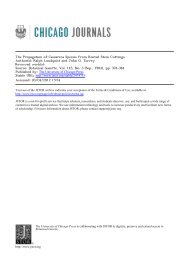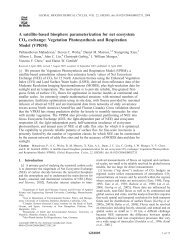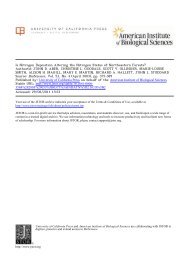Abstracts of Papers - Harvard Forest - Harvard University
Abstracts of Papers - Harvard Forest - Harvard University
Abstracts of Papers - Harvard Forest - Harvard University
Create successful ePaper yourself
Turn your PDF publications into a flip-book with our unique Google optimized e-Paper software.
RUGENSTEIN, SEANNA R. Department <strong>of</strong> Botany,<br />
Louisiana State <strong>University</strong>, Baton Rouge,<br />
LA 70803.<br />
- Seed testa patterns in Cercideae<br />
(Caesalpinioideae: Leguminosae).<br />
The caesalpinioid legume tribe Cercideae contains<br />
six genera in two subtribes. Scanning electron<br />
microscopy was utilized to study the anatomy <strong>of</strong><br />
seeds <strong>of</strong> 60 species representing 25% <strong>of</strong> the species<br />
in the largest subtribe and 83% <strong>of</strong> the species<br />
in the second. Several features <strong>of</strong> papilionoid<br />
legume seed anatomy have been shown to have<br />
taxonomic utility (Gunn, 1981; Kupicha, 1977;<br />
Lersten and Gunn, 1982). It was determined,<br />
during this study, that testa patterns in<br />
Cercideae differed in size rather than basic<br />
configuration, from those on papilionoid<br />
legume seeds. The basic testa patterns<br />
in Cercideae, as in papilionoid legumes,<br />
are papillose, reticulate, and foveolate.<br />
Other features <strong>of</strong> Cercideae seed anatomy,<br />
such as size and shape <strong>of</strong> hilar tongue,<br />
hilar groove, and micropyle, were also<br />
examined. The distribution <strong>of</strong> these anatomical<br />
features <strong>of</strong> the Cercideae seed seem to be<br />
indicative <strong>of</strong> subtribal and subgeneric<br />
taxonomic affiliations.<br />
RUSSELL, SCOTT D. Department <strong>of</strong> Botany and<br />
Microbiology, <strong>University</strong> <strong>of</strong> Oklahoma, Norman, OK<br />
73019 - Gametic fusion in Plumbago zeylanica:<br />
Ultrastructural evidence for gamete recognition and the<br />
preferential transmission <strong>of</strong> sperm plastids into the<br />
zygote.<br />
The mature microgametophyte <strong>of</strong> Plumbago zeylanica<br />
contains two dimorphic sperm cells which may be identi-<br />
fied by differences in both morphology and cytological<br />
content. One <strong>of</strong> the two male gametes is associated with<br />
the vegetative nucleus throughout its later development<br />
and is distinguished by the presence <strong>of</strong> a 30 micrometer<br />
long cellular projection which wraps around the vegetative<br />
nucleus. Cytological content <strong>of</strong> this sperm cell includes 0<br />
to 2 plastids and an average <strong>of</strong> 256 mitochondria. The<br />
other sperm cell is connected to the first sperm by<br />
plasmodesmata, is not closely associated with the vegeta-<br />
tive nucleus and lacks a prominent cellular projection. The<br />
second sperm cell contains 8 to 48 plastids and an average<br />
<strong>of</strong> 40 mitochondria. Upon discharge <strong>of</strong> the gametes from<br />
the pollen tube, both sperm cells are deposited in an<br />
intercellular region within the female gametophyte,<br />
located between the egg and central cell. The distinctive<br />
morphology <strong>of</strong> sperm plastids after fertilization can be<br />
used as a naturally occurring cytoplasmic marker to deter-<br />
mine which <strong>of</strong> these two sperms fuses with the egg and<br />
central cell. Evidence to date has suggested a preferential<br />
pattern <strong>of</strong> fusions between the plastid-containing sperm<br />
and the egg cell, transmitting a number <strong>of</strong> plastids into the<br />
incipient embryo. The other, plastid-poor sperm fuses with<br />
the central cell, transmitting numerous mitochondria into<br />
the incipient endosperm. This preferential pattern <strong>of</strong><br />
organelle inheritance strongly suggests that gametic fusion<br />
in the megagametophyte is not random in P. zeylanica.<br />
These results provide evidence for the presence <strong>of</strong> a final<br />
putative barrier to reproduction consisting <strong>of</strong> a gamete-<br />
level recognition system which may operate in the male<br />
and female gametes <strong>of</strong> this angiosperm.<br />
SANGSTER, ALLAN, G. Division <strong>of</strong> Natural Sciences,<br />
Glendon College, York <strong>University</strong>, Toronto, Ontario,<br />
M4N 3M6<br />
-Anatomy and silica distribution patterns in root<br />
and rhi zome <strong>of</strong> the grass Mi scanthus sacchari fl orus .<br />
Developmental and Structural Section 31<br />
Anatomy and deposited silica distributional patterns<br />
were investigated for the root and rhizome by means<br />
<strong>of</strong> scanning electron microscopy and energy dispersive<br />
X-ray microanalysis. In the root, silica deposits<br />
were confined to the single-layered endodermis in the<br />
form <strong>of</strong> large aggregates. In the rhizome, silica was<br />
present in two concentric regions consisting <strong>of</strong> the<br />
outer endodermis and the cells bordering the inner<br />
central cavity. Both these regions were several-<br />
layered, and the deposits were part <strong>of</strong> the cell wall<br />
layers rather than projecting aggregates. In both<br />
organs, a perivascular distribution pattern was<br />
evident, single-layered in the root but multi-layered<br />
in the rhizome. The root pattern is consistent with<br />
that investigated for other genera <strong>of</strong> the tribe<br />
Andropogoneae, as is the endodermal deposition site<br />
for the rhizome. However, rhizome deposits differ<br />
in form from other genera, and deposition around the<br />
central cavity has not been encountered previously.<br />
SCRIBAILO, ROBIN W. and U. POSLUSZNY, Department<br />
<strong>of</strong> Botany and Genetics, <strong>University</strong> <strong>of</strong> Guelph,<br />
Guelph, Ontario, Canada NlG 2W1<br />
- Morphology and establishment <strong>of</strong> seedlings <strong>of</strong><br />
Hydrocharis morsus-ranae.<br />
Hydrocharis morsus-ranae is an introduced aquatic<br />
plant species in North America. Little is known<br />
concerning the nature and morphology <strong>of</strong> seedling<br />
germination in this species. Consequently it has<br />
been assumed that Hydrocharis morsus-ranae must<br />
overwinter primarily through the production <strong>of</strong> large<br />
numbers <strong>of</strong> vegetative propagules. As part <strong>of</strong> a<br />
continuing study <strong>of</strong> this species an S.E.M. and field<br />
investigation <strong>of</strong> the seed and seedling morphology<br />
were initiated to contribute to the limited know-<br />
ledge <strong>of</strong> germination patterns within this genus and<br />
the Hydrocharitaceae as a whole. The seeds <strong>of</strong><br />
Hydrocharis morsus-ranae are highly unusual morpho-<br />
logically having their entire surface covered with<br />
hollow spiraliform tubercles. Germination occurs<br />
when the embryo <strong>of</strong> the exalbuminous seeds elongate<br />
splitting the tuberculate testa. The buoyant<br />
developing embryos then rise to the surface and the<br />
first foliage leaves emerge from a highly modified<br />
cotyledonary sheath. The young seedlings undergo<br />
several growth phases in which they first appear<br />
lemnid in habit before attaining their character-<br />
istic reniform leaf shape. In the field, substantial<br />
numbers <strong>of</strong> Hydrocharis morsus-ranae seedlings were<br />
found germinating among the turions <strong>of</strong> the same<br />
species. It is likely that reproduction from seed<br />
is more important in this species than previously<br />
thought.<br />
SHULTZ, LEILA M. Department <strong>of</strong> Biology, Utah<br />
State <strong>University</strong>, Logan UT 84322. - Leaf vessel<br />
measurements in desert perennials.<br />
The relationship <strong>of</strong> habitat and leaf vessel<br />
measurements is explored in comparative anatomical<br />
studies <strong>of</strong> sixteen closely related taxa (Artemisia<br />
spp.) from the cold deserts <strong>of</strong> western North America.<br />
Data are presented which document changes in vessel<br />
structure as well as relative volumes <strong>of</strong> tracheary<br />
tissue in habitats which are defined by a gradient<br />
<strong>of</strong> increasing aridity. As might be expected, vessel<br />
diameters decrease and width <strong>of</strong> cell walls increase<br />
with increasing aridity. Few studies, however, have<br />
addressed the possibility <strong>of</strong> volumetric changes in<br />
tracheary tissue. The relative volume <strong>of</strong> xylem to<br />
total tissue volume in the leaf appears to be a<br />
sensitive indicator <strong>of</strong> water stress. That ratio is<br />
presented and discussed here as a Xeromorphy Index.




